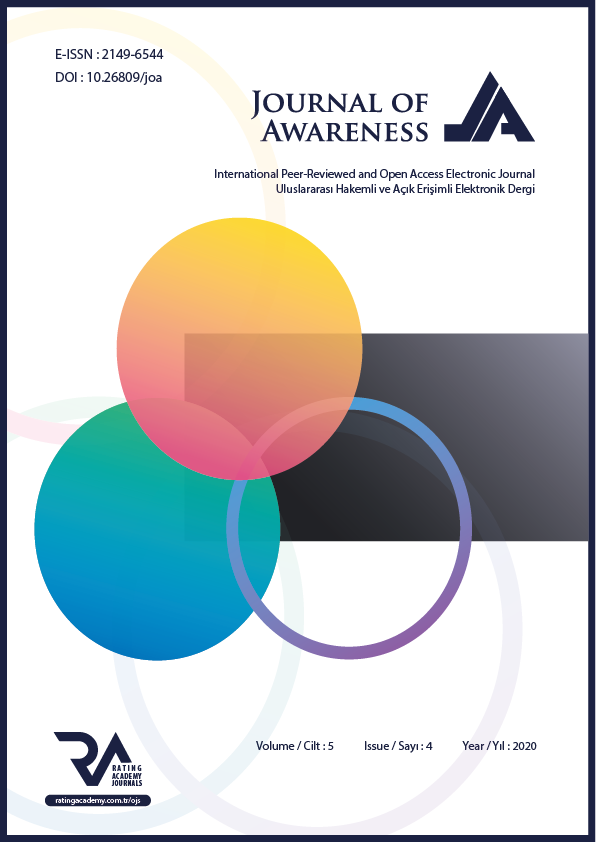STATISTICAL ANALYSIS OF THE INTERACTION BETWEEN GENDER ATTITUDE AND PERCEPTION OF HAPPINESS: AN APPLICATION ON UNIVERSITY STUDENTS
DOI:
https://doi.org/10.26809/joa.5.034Anahtar Kelimeler:
Happiness- Homogeneity Analysis- Gender AttitudeÖzet
Gender attitude is the concept defines the roles and behaviors that society and cultural structure expect from women and men throughout their lives. Gender equality emphasizes that women and men should have equal rights and opportunities and should not be gender-dependent. On the other hand, gender inequality can be defined as inequality in accessing resources and opportunities by sex. The effects of gender inequality can be observed in couples' relationships and social events in daily life. It is not possible to deny the role of gender inequality on people’s and society’s happiness level since it is one of the most important dynamics of social life. In this study, the relationship between gender attitudes and happiness perceptions of individuals were analyzed by using micro data. Within the scope of the study “Attitude Scale Regarding Gender Roles”, which is validated and reliable in the literature, was applied to a randomly selected sample. The sample was designed using both multistage sampling and stratified sampling techniques together. Stratification was planned on the basis of faculties. The prepared questionnaire was applied to a random sample of 3403 university students. The data collected were analyzed by homogeneity analysis and two-step cluster analysis, which are some of the Optimal Scaled Multivariate Analysis techniques. According to the results, it was observed that individuals whose gender attitude is relatively egalitarian are moderately happy and also, are the happiest with themselves. In addition, it is remarkable that the categories of success and love are closely located. Individuals with relatively more traditional attitude describe themselves as very happy. Additively it was determined that their source of happiness is their families, while the concept that makes them most happy is “health”. The findings are corroborated with the two-step cluster analysis results.
İndirmeler
Referanslar
ALPAR, R. (2013). Uygulamalı çok değişkenli istatistiksel yöntemler. Detay yayıncılık.
ARICI, F. (2011). Üniversite Öğrencilerinde Toplumsal Cinsiyet Rollerine İlişkin Algılar ve Psikolojik İyi Oluş. Yüksek Lisans Tezi.
AYTAÇ, S., & ÖNGEN, B. (2013). Üniversite Öğrencilerinin Toplumsal Cinsiyet Rollerine ilişkin Tutumları ve Yaşam Değerleri İlişkisi. Sosyoloji Konferansları, 1-18.
BAŞCI, B. (2016). Öğrencilerin Toplumsal Cinsiyet Tutumunın Çok Değişkenli Tekniklerle Belirlenmesi. İstanbul: Marmara Üniversitesi Sosyal Bilimler Enstitüsü, Yayımlanmış Yüksek Lisans Tezi.
BÜLBÜL, Ş., & GIRAY, S. (2011). Sosyodemografik Özellikler ile Mutluluk Algısı Arasındaki İlişki Yapısının Analizi. Ege Academic Review, 11.
DÖKMEN, Z. (2014). Toplumsal Cinsiyet Sosyal Psikolojik Açıklamalar. İstanbul: Remzi Kitabevi.
DÖKMEN YAŞIN, Z. (2000). Kendi Cinsiyetindekilere ve Diğer Cinsiyettekilere İlişkin Algı, Cinsiyet Rolleri ve Depresyon İlişkileri. Kriz Dergisi, 9-19.
DUMLUDAĞ, D., GÖKDEMIR, O., & GIRAY, S. (2016). Income comparison, collectivism and life satisfaction in Turkey. Quality & Quantity, 50(3), 955-980.
GIFI, A. Nonlinear Multivariate Analysis. 3. Edition. Chichester: John Wiley&Sons Publication, 1996.
GÖKDEMIR, O., & TAHSIN, E. (2014). Factors that influence the life satisfaction of women living in the Northern Cyprus. Social indicators research, 115(3), 1071-1085.
GRAHAM, C. (2004). “Can Happiness Research Contribute to Development Economics” Massachusetts Avenue Development Seminar, http://www.cgdev.org/doc/event%20docs/MADS/Graham.pdf, (21 Mayıs 2018).
HAIR, J. F. , ANDERSON, R. E., TATHAM, R. L., & BLACK, W. C. (1995) Multivariate Data Analysis. 4.Edition. New Jersey: Prentice Hall.
HOLAHAN, C. K., HOLAHAN, C. J., VELASQUEZ, K. E., & NORTH, R. J. (2008). Longitudinal change in happiness during aging: The predictive role of positive expectancies. The International Journal of Aging and Human Development, 66(3), 229-241.
HORI, M., & KAMO, Y. (2018). Gender differences in happiness: The effects of marriage, social roles, and social support in East Asia. Applied Research in Quality of Life, 13(4), 839-857.
KIMMEL, M. (2011). The Gendered Society. New York: Oxford University Press.
MAHON, N. E., YARCHESKI, A., & YARCHESKI, T. J. (2005). Happiness as related to gender and health in early adolescents. Clinical nursing research, 14(2), 175-190.
MENCARINI, L., & SIRONI, M. (2010). Happiness, housework and gender inequality in Europe. European Sociological Review, 28(2), 203-219.
MOOKERJEE, R., & BERON, K. (2005). Gender, religion and happiness. The Journal of Socio-Economics, 34(5), 674-685.
NORDENMARK, M. (2018). The importance of job and family satisfaction for happiness among women and men in different gender regimes. Societies, 8(1), 1.
PALAS KARACA, P., & ÇUBUKÇU AKSU, S. (2020). Sağlık Hizmetleri Öğrencilerinin Toplumsal Cinsiyet Rollerine İlişkin Tutumları ile Psikolojik İyi Oluşları Arasındaki İlişki. Yaşam Becerileri Psikoloji Dergisi, 91-100.
RUDOLF, R., & CHO, S. Y. (2011). The gender-specific effect of working hours on family happiness in South Korea (No. 77). Courant Research Centre: Poverty, Equity and Growth-Discussion Papers.
SHARMA, S. Applied Multivariate Techniques. 1.Edition. NewYork: John Wiley Publication, 1996.
STAVROVA, O., FETCHENHAUER, D., & SCHLÖSSER, T. (2012). Cohabitation, gender, and happiness: A cross-cultural study in thirty countries. Journal of Cross-Cultural Psychology, 43(7), 1063-1081.
VAN De GEER, J. P. (1993). Multivariate analysis of categorical data. Sage Publ..
YE, D., NG, Y. K., & LIAN, Y. (2015). Culture and happiness. Social indicators research, 123(2), 519-547.
ZEYNELOĞLU, S. (2008). Ankara’da Hemşirelik Öğrenimi Gören Üniversite Öğrencilerinin Toplumsal Cinsiyet Rollerine İlişkin Tutumları, Hacettepe Üniversitesi Sağlık Bilimleri Enstitüsü (Doktora Tezi), Ankara.
İndir
Yayınlanmış
Nasıl Atıf Yapılır
Sayı
Bölüm
Lisans
Telif Hakkı (c) 2020 Holistence Publications

Bu çalışma Creative Commons Attribution 4.0 International License ile lisanslanmıştır.
Yazarlar, makale Journal of Awareness’de yayınlanmak üzere kabul edildiğinde.makalenin içeriğindeki tüm telif haklarını, Rating Academy Ar-Ge Yazılım Yayıncılık Eğitim Danışmanlık ve Organizasyon Ticaret Ltd. Şti’ne devrederler. Yazarlar, patent hakları gibi telif hakkı dışındaki tüm mülkiyet haklarını saklı tutar.
Bu makalede yazar olarak listelenen herkes çalışmaya önemli, doğrudan, entelektüel katkılar yapmış olmalı ve bunun için kamu sorumluluğu almalıdır.
Bu makale daha once yayınlanmamış ve başka dergilerde yayınlanmak üzere gönderilmemiştir.










